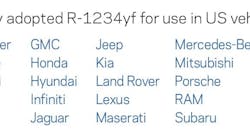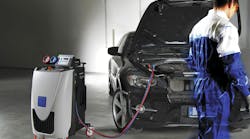The U.S. Department of Transportation is in the process of collecting research proposals on in-service truck platoons in an effort to develop a platooning deployment concept and accelerate deployment of related automated vehicle technologies.
"The United States Department of Transportation (USDOT) recognizes that cooperative automated driving systems will have a transformative impact on how our nation’s highways will operate in the future," the Broad Agency Announcement document reads. "One of the proposed near-term services is truck platooning. Truck platooning promises fuel savings to platooning trucks by enabling them to follow each other more closely, while still in a safe manner."
This project will build upon previous research and will assess the driver and system-wide impacts of commercial truck platooning technology.
"It will accelerate deployment of cooperative automated vehicle technologies to support the freight industry, enabling trucks to safely follow each other at distances that enable the vehicles to save fuel, thereby enhancing the economic competitiveness of freight shippers and lowering the costs of landed goods for consumers."
As part of this project, the Federal Motor Carrier Safety Administration (FMCSA) is also interested in collecting best practices related to commercial driver training, driver fatigue prevention, pre-trip inspections, roadside inspections, and the operations and maintenance by fleet operators of vehicle components that are critical to safe truck platooning operations.
Specific research questions to be answered include:
- What are the human factors impacts on truck drivers in long-haul operation of a truck platoon? Do they change as a truck driver becomes more familiar with the system? Do they change after a long period of platoon operations? What kind of information will the truck driver need to operate the system?
- How are the other road users' behavior impacted in the presence of truck platoon operations? Is there a value/need for some kind of dynamic platooning indication on platooning trucks to inform surrounding vehicles of platooning operations?
- How does the gap between the trucks impact the costs and benefits of platooning (fuel saving, safety, operating costs, vehicle maintenance, mobility/travel time) as well as the risks (number of cut-ins, truck driver's behavior/acceptance/fatigue)? How do road geometries, terrain, weather conditions, visibility, and other environmental characteristics and factors impact truck platooning operations?
- What are the benefits of truck platooning to fleet owners?
- What are the policy, operational and safety impacts of truck platooning?
The Federal Highway Administration (FHWA) anticipates contracting up to three of the submitted proposals, valued at $500,000 each. The field test deployment and assessment of these proposals will occur during Phase 2 of the project.
The deadline for responses is October 23, 2018. To learn more about the BAA and submit a response visit the FedBizOps website.


